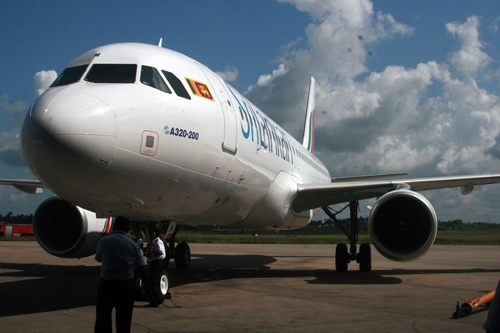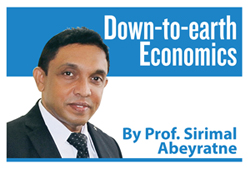Learning through a hard knock
View(s):
File picture of a SriLankan Airlines plane
Newly-appointed Prime Minister Ranil Wickremesinghe outlined the dangerous state of the Sri Lankan economy and the way forward, in his maiden speech last Monday. While the public is faced with increasing shortages of essential supplies and sky-rocketing prices largely due to the lack of foreign exchange for payments, the Prime Minister mentioned the challenge for the Treasury even to find one million dollars.
Elements of bankruptcy
At the same time, it was reported this week that there are a couple of ships which have brought fuel to Sri Lanka, anchored in the sea for few weeks awaiting for unloading, but the Ceylon Petroleum Corporation (CPC) has no dollars to pay; the unloading delays would further add up to the fuel costs. The fuel shortage has created chaos in the country and caused daily power-cuts pulling the economy further into the crisis.
Sri Lanka never had its official foreign exchange reserves of more than US$8 billion; it is not such a big amount to boast about, compared with the stock of foreign exchange reserves in our neighbouring countries – India $595 billion, Vietnam $109 billion, Singapore $362 billion, Malaysia $115 billion and, even Bangladesh $44 billion.
Then, the Prime Minister outlined the updated fiscal position of the government for the current year: Estimated government revenue is Rs. 1,600 billion, compared to the spending requirement of Rs. 4,000 billion. Government revenue has declined by Rs. 700 billion from its original estimate; of course, when businesses are down due to decreased input supply and increased production costs, government’s tax revenue must fall too. Similarly, government expenditure has increased by Rs. 700 billion from its original estimate; in this case too, due to higher domestic prices and higher interest rates, government expenditure must rise too.
As a result, as of now the estimated budget deficit is Rs. 2,400 billion – up by Rs. 1,400 billion from its original estimate; this is a staggering 13 per cent of GDP. On top of all that, the Treasury coffers have no money to pay public sector salaries for which the Central Bank must return to print money again; this would add up to a further depreciation of the rupee and further increase inflation!
The government’s cap on borrowing has been set at Rs. 3,200 billion for 2022, out of which Rs. 1,950 billion has already been exhausted by now during the past few months of the year. It requires the government to increase the borrowing limit up to Rs. 4,000 billion, which would increase the country’s debt burden.
Carrier of the nation?
While the country is getting trapped in the aggravating debt crisis even more and more, the Prime Minister indicated a couple of “bitter pills” which would relieve the crisis but increase the pain, even though it is not the “whole prescription” that is required. The bitter pills were basically about some of issues that has resulted in an unsustainable government budget.
Here is the problem with fuel pricing: As of now the government’s losses from sales of fuel per litre are Rs. 84.38 for 92 octane petrol, 71.19 for 95 octane petrol, 131.55 for diesel, 136.31 for super diesel, 294.50 for kerosene oil. This means that even though domestic fuel prices have gone up by massive amounts in the past few months (largely due to currency depreciation), the government which sets its prices still incurs losses; the losses are transferred to the government budget so that part of the tax revenue should be spent to cover the losses.
 This is exactly why the domestic fuel prices should be flexible enough to represent its cost, which would be a massive saving for the government budget. If it’s a result of a sharp currency depreciation – a primary problem with external finance, then the country should have generated adequate foreign exchange to meet payments requirements; this should have been done through “export growth” and, not with remittances, tourism income or borrowings.
This is exactly why the domestic fuel prices should be flexible enough to represent its cost, which would be a massive saving for the government budget. If it’s a result of a sharp currency depreciation – a primary problem with external finance, then the country should have generated adequate foreign exchange to meet payments requirements; this should have been done through “export growth” and, not with remittances, tourism income or borrowings.
The economics of loss-making public enterprises have been discussed and debated extensively in Sri Lanka as well as elsewhere around the world. In spite of much talk over decades, there has been little implementation. Battered with fuel shortages and power cuts, Sri Lanka today does not need any more evidence to confirm that the traditional models of public enterprises as “state monopolies” under political authorities have failed to deliver the respective services to the public, contrary to promises.
The Prime Minister has proposed to privatise the “national carrier” – SriLankan Airlines; think differently, it is even difficult for us to understand “how an airline can be the carrier of the nation?” The biggest loss-making public enterprises in Sri Lanka – CPC, CEB and SriLankan, also require budgetary transfers and bank borrowings with government guarantees, crowding out investment funds that are otherwise available for private credit. Thus, they not only burden the government budget, but also obstruct the country’s economic progress.
Spending beyond means
The ultimate source of the crisis can be attributed to the nation’s practice of “spending beyond the capacity” whether it is government finance or external finance. And, how to spend beyond the given cash flows is always through borrowing. Even if it is corruption and robbing (which is the common perception nowadays), irrespective of their magnitudes these expenses are also part of the spending either from the internal finance (government budget) or from the external finance (balance of payments).
The country is now at the end of its over-spending journey, virtually there is little room for further movement; someone may have to provide our “next meal”, without which we would starve, leave the “default” issue aside. The next few weeks or months may be the worst time of the crisis; it may be avoided or, at least, be mitigated only with some emergency finance through further borrowings from somewhere – a multilateral or bilateral source. Perhaps, immediate investments by some foreign investors, if possible, at all, might be a better option.
However, the deeper issue in question is how to achieve both the government finance and external finance stability. If we had addressed these two issues over the past few years or decades, today we would have not been in this situation. But now we need to do it as an urgent need, with severe pain due to its high cost of adjustment.
Two accounts
The first – achieving government finance stability, requires reforms on the part of tax revenue collection and on the part of spending every tax-rupee productively for the value of money. Public enterprise reforms, public sector reforms, targeted subsidies, and eliminating corruption are essential components of this fiscal reforms.
The second – achieving external finance stability, requires returning to export growth (instead of depending on tourism and migrant-worker remittances) and FDI expansion (instead of depending on foreign borrowings). Over a long period of time, these two most important sources of external finance – exports and FDI – have been overlooked and thus the country is in today’s foreign exchange and debt crisis.
By the way, popularly we used to blame the politicians all the time for bringing the country to its current dire status. But the civil society that has been organised into numerous lobbying platforms has also contributed to the current crisis.
If the reforms in the above two areas were blocked by the public by any means, it is a contribution to the crisis; if the important decisions of the government were averted by public protests, it is a contribution to the crisis; and if the public were also part of bribery and corruption, it is a contribution to the crisis. Finally, we all have learnt the lesson through a hard knock, although we already knew it was going to be the final outcome.
(The writer is a Professor of Economics at the University of Colombo and can be reached at sirimal@econ.cmb.ac.lk and follow on Twitter @SirimalAshoka).
Hitad.lk has you covered with quality used or brand new cars for sale that are budget friendly yet reliable! Now is the time to sell your old ride for something more attractive to today's modern automotive market demands. Browse through our selection of affordable options now on Hitad.lk before deciding on what will work best for you!


